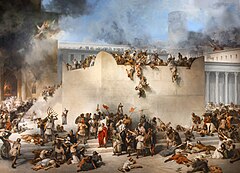
Back Tisj'a be'Aw Afrikaans ذكرى خراب الهيكل Arabic ذكرى خراب الهيكل ARZ Девети ав Bulgarian Tixà be-Av Catalan Tish’a be’Av CEB Tiš'a be-av Czech Tisha B'Av Danish Tischa beAv German Tiŝ'a be'av Esperanto
| Tisha B'Av | |
|---|---|
 Destruction of the Temple of Jerusalem, by Francesco Hayez | |
| Official name | Hebrew: תשעה באב English: Ninth of Av |
| Type | Jewish religious and national |
| Significance | Mourning the destruction of the ancient Temples and Jerusalem, and other major calamities which have befallen the Jewish people. |
| Observances | Fasting, mourning, prayer, abstaining from physical pleasures |
| Date | 9th day of Av (if Shabbat, then the 10th of Av) |
| 2023 date | Sunset, 26 July – nightfall, 27 July[1] |
| 2024 date | Sunset, 12 August – nightfall, 13 August[1] |
| 2025 date | Sunset, 2 August – nightfall, 3 August[1] |
| 2026 date | Sunset, 22 July – nightfall, 23 July[1] |
| Frequency | annual |
| Related to | The fasts of Gedalia, the Tenth of Tevet and the Seventeenth of Tammuz, the Three Weeks & the Nine Days |
Tisha B'Av (Hebrew: תִּשְׁעָה בְּאָב[a] Tīšʿā Bəʾāv; IPA: [tiʃʕa beˈʔav] , lit. 'the ninth of Av') is an annual fast day in Judaism. A commemoration of a number of disasters in Jewish history, primarily the destruction of both Solomon's Temple by the Neo-Babylonian Empire and the Second Temple by the Roman Empire in Jerusalem.[2]
Tisha B'Av precedes the end of the three weeks between dire straits. This day is regarded as the saddest day in the Jewish calendar. It is categorized as a day destined for tragedy.[3][4] Tisha B'Av falls in July or August in the Gregorian calendar.
Observances of the day include five prohibitions, most notable of which is a 25-hour fast. The Book of Lamentations, which mourns the destruction of Jerusalem, is read in synagogue, followed by the recitation of kinnot, liturgical dirges that lament the loss of the Temples and Jerusalem. As the day has become associated with remembrance of other major calamities which have befallen the Jewish people, some kinnot also recall events such as the murder of the Ten Martyrs by the Romans; expulsions from England, Spain, and elsewhere; massacres of numerous medieval Jewish communities by Crusaders; the Holocaust;[2] and the October 7, 2023 Hamas terrorist invasion of Israel.[5][6]
- ^ a b c d "Dates for Tisha B'Av". Hebcal.com by Danny Sadinoff and Michael J. Radwin (CC-BY-3.0). Retrieved 26 August 2018.
- ^ a b "Tisha Be-Av - Jewish Tradition". yahadut.org. Retrieved 13 June 2024.
- ^ Elozor Barclay; Yitzchok Jaeger (2003). Guidelines: Over Four Hundred of the Most Commonly Asked Questions about the Three Weeks. Targum Press. p. 65. ISBN 978-1-56871-254-3.
Hashem condemned this day to become destined for national disasters throughout history...
- ^ Pinchos Yehoshua Ellis (2005). Seasons in halacha. Targum Press. p. 267. ISBN 978-1-56871-369-4.
Tisha B'Av initially became destined for tragedy...
- ^ Hajdenberg, Jackie (9 August 2024). "For the first Tisha B'Av after Oct. 7, new liturgy and traditions mourn a fresh tragedy". Jewish Telegraphic Agency est 1917. Yeruham, Israel. Retrieved 15 August 2024.
Every year, on the fast day of Tisha B'Av, Jewish communities worldwide chant a series of dirges, called "kinnot," that commemorate the tragedies of Jewish history in verse, from the destruction of the temples to the Crusades to the Holocaust.
- ^ Harkov, Lahav (12 August 2024). "The rabbis adding Oct. 7 to their Tisha B'Av lamentations". Jewish Insider (JI). United States. Retrieved 15 August 2024.
Some congregations in Israel and the Diaspora will have new texts to read about more recent, tragic events of Oct. 7, the greatest massacre of Jewish people since the Holocaust.
Cite error: There are <ref group=lower-alpha> tags or {{efn}} templates on this page, but the references will not show without a {{reflist|group=lower-alpha}} template or {{notelist}} template (see the help page).